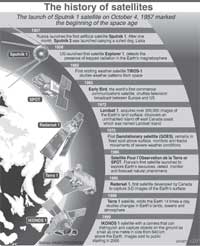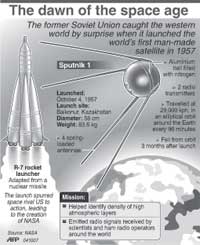
The dream of space, 50 years after first satelliteMore than 50 years ago, visionaries like the British science fiction writer Arthur C. Clarke and the German (and American) rocket engineer Wernher von Braun laid out a series of steps for the journey into space. Clarke presented his vision in a 1951 book The Exploration of Space and von Braun's proposals appeared in a series of Collier's magazine articles published between 1952 and 1954.
A few years later - indeed, 50 years ago this week - the Soviet Union launched the first earth orbiting satellite, inaugurating the space age. After 50 years, many elements of the original vision have been achieved, some have failed, and there have been more than a few surprises. Clarke and von Braun encountered a wall of skepticism when their proposals first appeared. The public viewed space travel as science fiction, a form of popular entertainment thought to have little chance of realization. But Clarke, von Braun, and others persevered. We would, they predicted, launch satellites, dispatch humans on orbital flights, assemble a large earth-orbiting space station, build reusable space shuttles, construct space telescopes, and send humans to the moon, Venus, and Mars. Clarke explained how humans could build communication satellites. Von Braun predicted that military forces would use orbiting platforms to observe troop movements and prevent surprise attacks. All of these visions appeared before the first artificial satellite was launched. In 1959, officials at the United States National Aeronautics and Space Administration (NASA) adopted most of these steps as part of their long-range plan. The Soviet Union engaged the US in a race to the moon. Government support for realizing the vision inspired the British film maker Stanley Kubrick to present the steps in his classic movie 2001: A Space Odyssey , released in 1968. Clarke helped to write the screenplay. The movie depicted a large space station, a winged space shuttle, a lunar base, and astronauts on a trip to the outer solar system. True to the plan, humans built scientific satellites, communication satellites, reconnaissance or "spy" satellites, space stations, and reusable space shuttles. They sent robotic spacecraft to the moon, Venus, Mars, and other planets, and humans to the moon. In those respects, the original vision was achieved. The human space effort, nonetheless, departed from the plan in unexpected ways. The International Space Station, currently under construction, does not resemble the large, rotating wheels presented by Kubrick, Clarke, and von Braun. Early planners viewed the space station as an assembly point for expeditions to the moon and planets. Kubrick's 900-foot wide wheel rotated in such a fashion as to produce a sense of gravity equal to that felt on the moon, to which many of the station's fictional occupants were bound.
The real space station is a micro-gravity research laboratory with no capability to launch trips to the moon or beyond. Larger capabilities were part of the original space station plan, approved in 1984, but subsequently disappeared as the cost of the facility grew. Nor has the US space shuttle accomplished its goals. Von Braun predicted that the US would need to launch 364 space shuttles in less than one year to prepare for the first lunar voyage. When the space shuttle was approved in 1972, NASA officials predicted that they would launch one every week or two. But the space shuttle has proven far more difficult and costly to operate than anticipated, flying only four times per year on average. It has neither reduced the cost of space access nor made space flight safe and routine, as promised. When the shuttle is retired around 2010, NASA will replace it with an old-fashioned spacecraft with no wings at all. In contrast to human space flight, which has lagged behind expectations, the robotic space effort has exceeded them. Von Braun endorsed an automated telescope in space, but thought that astronauts would need to visit the instrument to change the film. Early plans for military reconnaissance stations assumed that soldiers would be stationed on board. Clarke believed that astronauts would be dispatched to maintain and operate communication satellites. Kubrick suggested that people - accompanied by a computer - would pilot spacecraft to explore planets like Jupiter and Saturn. But none of this proved necessary, owing to remarkable advances in robotics, solid-state electronics, imaging, data collection, and communication. Sensors that convert light waves into electronic signals eliminated the need for film on space telescopes, while computer chip technology (integrated circuits) allowed communication satellites to be operated without periodic human repair.
Robotic spacecraft are currently returning information from the outer regions of the solar system and roving the surface of Mars. No military force has yet perceived the need to station soldiers on its various reconnaissance, communication, or navigation satellites. Robotic technology is advancing more rapidly than the technologies supporting human space flight. Around the world, clever scientists, engineers, and entrepreneurs are working to realize the remainder of the space exploration dream. Watch for humans to establish space tourism, return to the moon, and attempt an expedition to Mars. Advances in robotics will continue to occur, with automated spacecraft that can dig and swim, and telescopes that can look for earth-like planets around nearby stars. If the past is any guide, much of what seems like science fiction today will become reality tomorrow. (Howard E. McCurdy is a professor in the School of Public Affairs at American University in Washington, D.C., and author of six books on the history of space exploration. His latest, Robots in Space, coauthored with Roger D. Launius, will be published in December.) Copyright: Project Syndicate, 2007. Exclusive to The Sunday Times |
|| Front
Page | News | Editorial | Columns | Sports | Plus | Financial
Times | International | Mirror | TV
Times | Funday
Times || |
| |
Reproduction of articles permitted when used without any alterations to contents and the source. |
© Copyright
2007 | Wijeya
Newspapers Ltd.Colombo. Sri Lanka. All Rights Reserved. |


